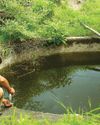Prøve GULL - Gratis
Dogged disruption
Down To Earth
|September 01, 2025
Free-ranging dogs have risen as predators due to the decline in vulture numbers in India. Now, these canines threaten other animals and humans with feral behaviour, disease transmission

FROM A place of disposal to a conservation haven, Rajasthan's Jorbeer has seen an unusual yet natural transformation. Located on the outskirts of Bikaner city, the 56 sq km ground was a regulated site for disposal of animal carcasses. This naturally attracted scavengers, particularly vultures.
In 2008, the state government officially named the ground Jorbeer Conservation Reserve to boost populations of vultures and other raptors. Since then the reserve has served as a regulated vulture feeding site, with nature lovers flocking to spot native and migratory vultures. However, visit the ground now and it will appear overrun by not vultures, but dogs—1,000 in number. Even if a few vultures swoop down to feed on the remains, the dogs chase them away to protect what they deem is now their territory.
Jorbeer, the Keru landfill in Jodhpur district and Bhadariya oran (sacred grove) in Jaisalmer are just some sites in Rajasthan where dogs and vultures inadvertently share a feeding guild. In all the sites, dogs seem to be the dominant scavenger.
This scenario is likely a case of trophic cascade—an ecological phenomenon that describes changes in the natural food chain due to removal of one predator and emergence of another. To put it another way, dogs are increasingly replacing vultures as dominant scavengers, not just in Rajasthan but across the country.
This shift happened after the 1990s, when the vulture population began to plummet in India because of diclofenac. The non-steroidal anti-inflammatory drug (NSAID) was used on livestock and poisoned vultures that fed on carcasses with traces of the medicine. By 2000, populations of three major species in India—white-rumped vulture (Gyps bengalensis), long-billed vulture (Gyps indicus) and slender-billed vulture (Gyps tenuirostris) —plummeted by almost 98 per cent. The International Union for Conservation of Nature (IUCN) classified them as critically endangered.
Denne historien er fra September 01, 2025-utgaven av Down To Earth.
Abonner på Magzter GOLD for å få tilgang til tusenvis av kuraterte premiumhistorier og over 9000 magasiner og aviser.
Allerede abonnent? Logg på
FLERE HISTORIER FRA Down To Earth

Down To Earth
COP OF TALK
The UN's 30th climate summit, COP30 in Belém, was billed as the COP of truth and implementation.It was an opportunity for the world to move beyond diagnosis to delivery. Instead it revealed a system struggling to prove its relevance.
14 mins
December 01, 2025
Down To Earth
1,500 days, and an alarm for new climate
SEASONS ARE the compass that guide humans to survive and thrive as a society. What happens if seasons lose their distinct character and predictable rhythm? This is no longer a theoretical question. The Earth is entering a new climate regime, its atmosphere now saturated with greenhouse gases at levels without precedent in human history. And the earliest sign of this shift is the near-dissolution of familiar seasons; all merging and dissipating like the pupa inside the chrysalis, but, not to give birth to that mesmerising butterfly. This metamorphosis is manifest in the blizzard of weather events, extreme in severity and unseasonal by nature and geography.
2 mins
December 01, 2025

Down To Earth
Rights in transit
A recent dispute over transport and trade of kendu leaves in Odisha highlights differing interpretations of forest rights laws in the state
6 mins
December 01, 2025
Down To Earth
Roots of peace
Kerala's forest department plants fruit and fodder trees to ease human-wildlife tensions
2 mins
December 01, 2025

Down To Earth
Flattened frontiers
Efforts to reclaim degraded land from Chambal ravines expose both people and biodiversity to ecological risks from erosion and flooding
5 mins
December 01, 2025

Down To Earth
INDIA'S DRY RUN
India is poised to be a global hub of data centres—back-end facilities that house servers and hardware needed to run online activities.
21 mins
December 01, 2025

Down To Earth
Bangla generic drugs to the rescue
A buyer's club for generic cystic fibrosis drugs sourced from Bangladesh highlights the country's laudable pharma development
4 mins
December 01, 2025

Down To Earth
Direct approach
A new direct cash transfer scheme as well as decades of women-centric programmes yield an electoral windfall for the ruling alliance in Bihar
5 mins
December 01, 2025

Down To Earth
HIDDEN RESOURCE
Punjab's 1.4 million abandoned borewells offer a chance to mitigate flood damage and replenish depleting groundwater
4 mins
December 01, 2025
Down To Earth
Corporate bias
INDIA'S DRAFT Seeds Bill, 2025, introduced by the Centre in mid-November, proposes a few key changes.
1 min
December 01, 2025
Listen
Translate
Change font size
